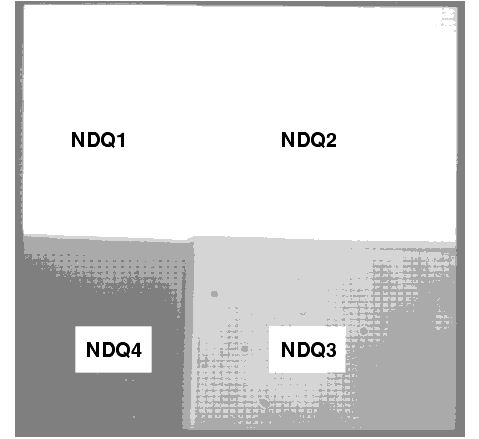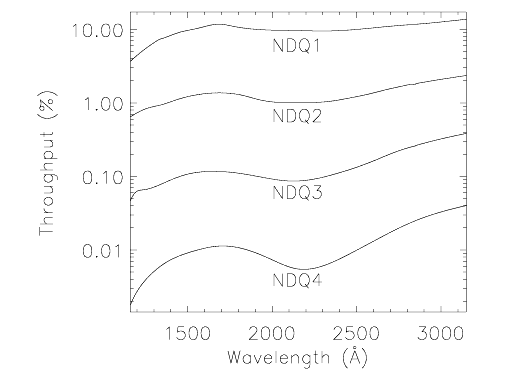



Supported neutral-density-filtered aperture for slitless 1st order MAMA spectroscopy of targets too bright to be observed with a clear aperture. The F25NDQ filter is unique in that it is divided into four quadrants, each having a different neutral density factor. In clockwise order starting from the upper left these are F25NDQ1, F25NDQ2, F25NDQ3, and F25NDQ4, where the number appended to each name is the approximate dex ND factor. Approximate dimensions of each quadrant and the default location of an external target in each quadrant are given in Table 13.33.
The default aperture locations where the target is placed in each quadrant are significantly offset from the center of the detector in both the spatial and the dispersion directions. For observations at these nominal aperture locations this will cause a significant shift in the wavelength coverage for any given grating setting. For example, when observing with G140L in F25NDQ1, wavelengths shorter than about 1330 Å will fall off the detector. Users may wish to use a POS-TARG to bring the target back closer to the center line of the detector. However, if the target would violate BOP restrictions in any quadrant of the aperture, the restrictions regarding pointing close to objects violating safety limits discussed in Chapter 7 and STIS ISR 2000-01 will apply. This latter rule renders the F25NDQ4 quadrant mostly useless, and the F25NDQ3 quadrant is redundant with the full field F25ND3 aperture, so in practice only the F25NDQ1 and F25NDQ2 quadrants are commonly used. Also the dividing lines between the quadrants are somewhat displaced from the center of the detector and are not quite parallel to the detector edges (see Figure 13.82), so observers for whom the exact locations of the quadrant boundaries are important should consult help@stsci.edu.

Note: Aperture throughputs values for NDQ1 and NDQ4 at  <1330 Angstroms and for NDQ2 and NDQ3 at
<1330 Angstroms and for NDQ2 and NDQ3 at  >2850 Angstroms are extrapolated.
>2850 Angstroms are extrapolated.



|
Space Telescope Science Institute http://www.stsci.edu Voice: (410) 338-1082 help@stsci.edu |